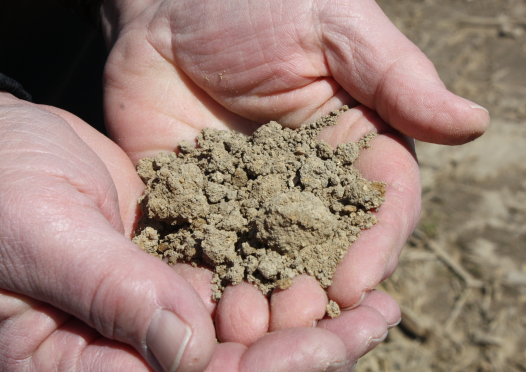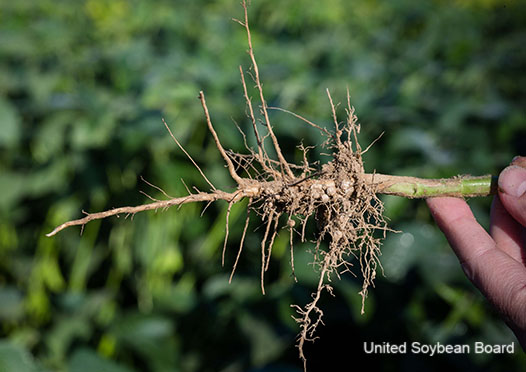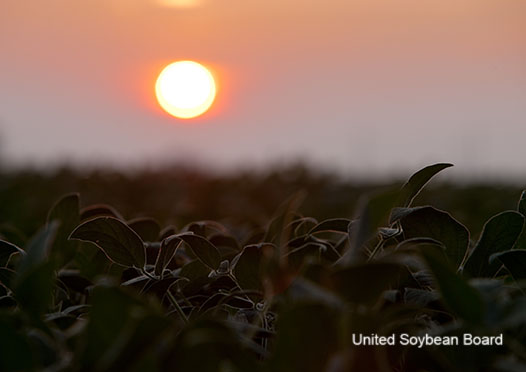ILSOYADVISOR POST
Diagnostics: 2014: “Perfect Storm” for N Deficiency in Soybeans
You don’t have to drive far in Illinois to see that soybeans are struggling with unseasonably wet conditions. Many fields have large yellow areas. Standing water creates high stress conditions for a soybean field; but even in areas without visible standing water, soybeans are appearing yellowed and stunted.
According to Fred Below, professor of crop sciences at the University of Illinois, many Illinois soybean fields are showing classic nitrogen deficiency symptoms, resulting from a lack of early-season nitrogen and poor nodulation.
“Soybeans do not like to be too wet or too cold, and nodules are easily stressed,” he explains. “Under current conditions, soybeans may not be getting adequate amounts of nitrogen from fixation.”
Meeting N requirements for soybeans
In a typical year, soybeans draw nitrogen from two sources: available soil nitrogen and nitrogen fixation. But weather conditions in 2014 do not reflect a typical year. According to the State Climatology Office for Illinois, the statewide average precipitation for June 2014 in Illinois was 6.78 inches, 2.58 inches above average and the 8th wettest June on record.
In addition, Below says that data from the N-Watch program, which tested residual nitrogen levels at approximately 400 sites throughout Illinois, found little to no residual nitrogen present in most of the samples collected in spring 2014.
“We had good utilization of nitrogen by the corn crop last year, resulting in less residual soil nitrogen and a cool, wet spring this year, which definitely limits nitrogen mineralization,” says Below. “That adds up to the perfect early-season conditions for a nitrogen deficiency situation in soybeans.”
Below explains that soybeans need about five pounds of nitrogen for each bushel of yield, or about 300 pounds of available N for a 60-bushel yield. Typically, soybeans derive about half of the needed nitrogen from the soil and half from fixation.
“In some years, soybeans have some residual N to help them get off to a good start until nodulation starts, typically around V2/V3,” says Below. But wet soil conditions also can lower nodulation, creating a perfect storm for nitrogen deficiency throughout the growing season.
Soybeans hate wet feet
High soil water levels stress soybeans because they can limit the amount of oxygen available to the roots and interfere with the uptake of soil nutrients, in addition to interfering with nodulation and nitrogen fixation.
Fortunately, there’s a simple way to understand if nodules are working.
“Color is everything when it comes to nodules,” explains Below. “If they’re not pink on the inside, they’re not fixing nitrogen.” He adds that nodules that are grey or green are not living up to their nitrogen-fixing potential.
“Some growers say that nodules will pink up later, but we’ve seen that when you stress a nodule that much, it never really comes back,” he adds.
Early research observations
As part of Below’s Six Secrets of Soybean Success, a checkoff-funded program to evaluate various soybean management practices, Below has been evaluating the response of soybeans to supplemental fertility, including nitrogen. In previous years, results from added nitrogen have been mixed, but this year, he said the differences are already visible.
“Plants with supplemental N are a deeper green, larger and there’s more uniformity within the row,” he explains.
“We won’t know for sure how this translates to yield until we get the research data this fall,” he says. “Then we’ll be more informed about how supplemental nitrogen performed against our standard management approach.”
But Below suggests that 2014 is shaping up to be a good year for growers interested in trying supplemental nitrogen on their beans.
Will supplemental N pay in 2014?
Before adding supplemental nitrogen to soybean fields, Below recommends scouting fields carefully and digging sample plants to check the nodulation. By cutting nodules open to see what color they are, growers can determine how effectively nitrogen fixation is occurring.
He recommends that growers evaluate nodule color in areas of the field that appear normal, as well as those that appear stressed. “Even if a crop is not showing signs of stress in the upper portions of the plant, if the nodules are not pink, they’re not working, and nitrogen deficiency may continue to be a problem.”
He adds that signs of nitrogen deficiency in soybeans are somewhat different from signs of nitrogen deficiency in corn. He suggests growers look for an overall yellowing of the plant and stunted growth as clues to possible nitrogen deficiency. Examination of the roots for the number of nodules and nodule color also will point to possible causes of the stress.
Below suggests that growers interested in using supplement nitrogen apply 50 – 75 pounds of nitrogen (in the form of urea with Agrotain® or ammonium sulfate) per acre at the R3 growth stage, which is mid-July in most parts of Illinois.
“Typically we would suggest growers wait until August to use supplemental nitrogen to help out a ‘lazy bean,’ but we’re finding that nodules are already underperforming, so we’re recommending growers add nitrogen now for the best response.”
He estimates that growers would need to see a five-bushel yield bump to cover the costs of nitrogen and application.
A word of caution
Below does have a word of caution for growers interested in trying this approach: It may work in 2014, but it won’t work every year.
“One thing to keep in mind for growers who try supplemental N this year: If you see a huge response this year, don’t expect to see the same results next year. Soybeans typically pull a lot from nodules, and this year they’re getting less N from the soil and less from the nodules.”
But as far as 2014 is concerned, it’s really shaping up to be the perfect N on beans year.





Comments
Add new comment